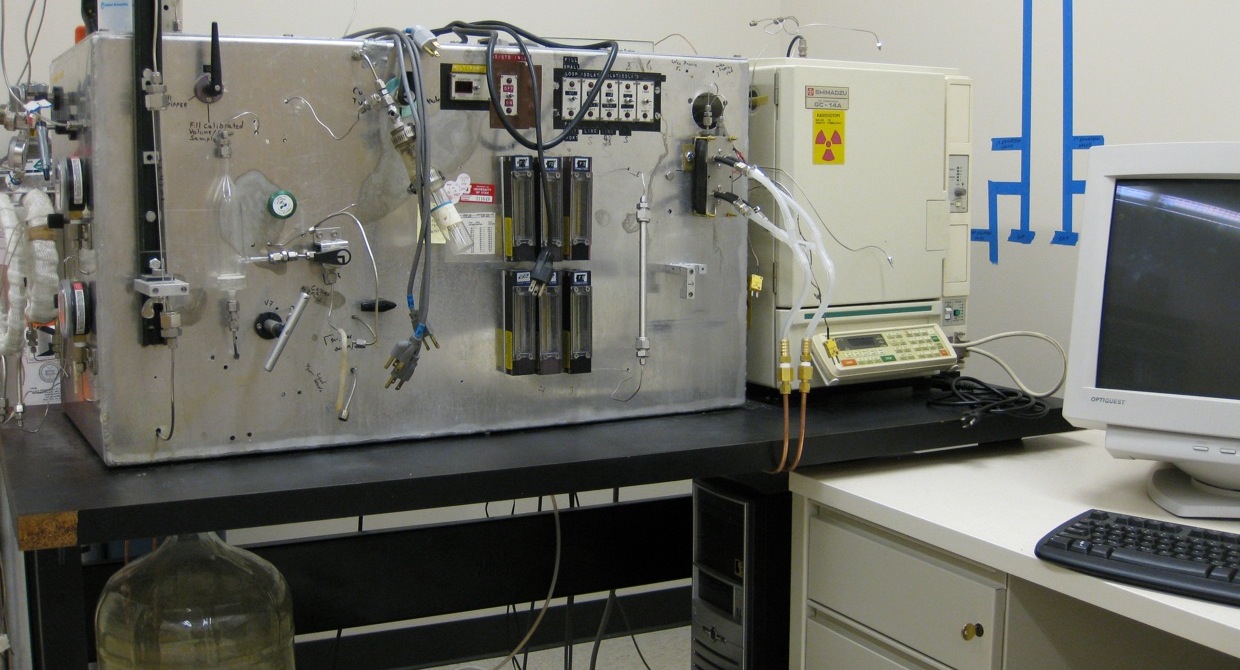Chlorofluorocarbons
 The Environmental Tracers Lab is used to detect the concentrations of chlorofluorocarbons
(CFC’s) in groundwater. CFC’s are a manmade organic compound utilized for a wide range
of industrial and domestic purposes, such as refrigerants and propellants. This use
has resulted in large atmospheric releases of CFC gases over the last 50 years. Atmospheric
CFC concentrations have increased due to higher usage, as well as relatively long
atmospheric residence times, ranging between 44 to 180 years.
The Environmental Tracers Lab is used to detect the concentrations of chlorofluorocarbons
(CFC’s) in groundwater. CFC’s are a manmade organic compound utilized for a wide range
of industrial and domestic purposes, such as refrigerants and propellants. This use
has resulted in large atmospheric releases of CFC gases over the last 50 years. Atmospheric
CFC concentrations have increased due to higher usage, as well as relatively long
atmospheric residence times, ranging between 44 to 180 years.
Precise CFC measurements have been conducted beginning in 1978 throughout the globe as a part of the Atmospheric Lifetime Experiment, producing an excellent recorded record of global CFC concentrations. One advantage offered by CFC’s as a tracer is that they are uniformly distributed throughout the atmosphere. Partitioning of atmospheric CFC’s into water vapor depends on the atmospheric concentration and the solubility relationships. Infiltration of meteoric water into the subsurface carries dissolved CFC gases. Once isolated from the atmosphere the concentration of CFC’s in water remains constant. When a groundwater sample is obtained and analyzed for the CFC concentration, the concentration in the water is related to the atmospheric CFC concentration at the time the water entered the subsurface, allowing for a recharge age measurement. This technique can be used to determine the recharge age of waters dating back to around 1945.
Our facility located at the University of Utah conducts continuing research on CFC’s and groundwater. This type of research requires precise equipment that has been designed specifically for this purpose. No off-the-shelf, commercially manufactured systems are available. The system consists of a gas chromatography set up where CFC’s are stripped from the water and measured against a standard gas. Due to the highly specialized nature of the instrument, operators must have a specific understanding of the equipment and is functionality. All laboratory employees using this equipment have demonstrated their qualifications though months of hands-on experience. As a general rule our laboratory follows the same protocols and procedures and the U.S. Geological Survey CFC Laboratory in Reston, VA.
The CFC concentrations are referenced to average air compositions measured at Niwot Ridge, Colorado (Climate Monitoring and Diagnostics Laboratory (CMDL)) of the National Oceanic and Atmospheric Administration (NOAA), U.S. Department of Commerce. The standard deviation of repeated measurements is typically less than 2 percent of the reported value for CFC-11 and CFC-12, and about 3 percent for CFC-113, but increases as concentrations approach the detection limits of about 1 pg/kg for CFC-113 and about 0.5 pg/kg for CFC-11 and CFC-12. The analytical precision is about 50 percent at the detection limit and about 3 percent above 25 pg/kg. Eight standards and a blank were used for calibration because the ECD response does not vary linearly with concentration. The calibration ranges of the gas chromatograph were 0-1,200 pg/kg for CFC-11, 0-2,500 pg/kg for CFC-12, and 0-900 pg/kg for CFC-113. Reported concentrations beyond the above calibration limits should be considered as estimates of concentrations of the three CFC’s (USGS, 2004).
Samples collected for CFC analysis must be collected in a specific way that maintains the CFC concentrations of the original water. For more information on collection procedures of the USGS click here.
